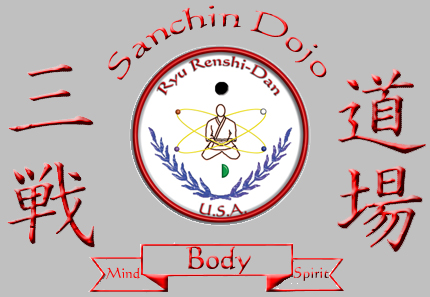|
|
|

The Sanchin Dojo is a form of Ryu Renshi-Dan Karate which was formalized by Kyoshi Jose Guzman. At the Sanchin Dojo we strive to help every student achieve their personal best in Martial Arts and in their life. The following is a summary of each aspect of what we teach our students at the Sanchin Dojo. All of our instructors have many years of experience in martial arts and teaching.
Karate - Do:
Now, shortened to Karate, Karate-do means the Art of the Empty Hand. Karate is a fighting art using only the bare hands and feet, which has developed over centuries. It began when the Chinese occupied Okinawa, Part of the Ryukyu chain of island in the 16th century, and forbid the people from possessing weapons. It was intended as a means of defending oneself against brigands and armed invading troops. At the time peasants trained in secret and, little by little, they invented various techniques, which enabled them to defend themselves against attacks.
Karate became a discipline resembling to Judo, but maintained its own characteristics, using the feet, hand, and legs to deliver blows to the vital points of an opponent, and refraining from grappling and throwing methods typical of Judo and Ju-Jitsu. Funakoshi Yoshitake was the true father of modern Karate. After the fall of Japan in 1945, the American authorities banned all Japanese combat sports with the exception of Karate. According to certain writers, the fact was that American soldiers wanted to learn some Karate techniques to improve their own close-combat fighting skills.
Karate-do remains an art and a sport whose motto is to “never strike the first blow”. It is a defensive, “peaceful” art.
The Essential Principles of Karate-do:
Ø Powerful blows requiring a well-developed musculature.
Ø Concentration of force to maximize its effect.
Ø Utilization of the force of reaction, which gives greater power of penetration and of "breaking".
Ø Breath control and the development of a low, strong center of gravity.
Ø Speed of movements and good "timing" of attacks.
Ju-Jitsu:
The Sanchin Dojo, as well as teaching traditional Karate also teaches Ju-Jitsu techniques to the student. Shihan Andy Dowdell has studied Ju-Jitsu for about ten years and has incorporated into the system.
Ju-Jitsu is a science of softness. They are techniques of combat that were elaborated by the Kamakura period (1185 – 1333) in Japan. It was intended for disarmed warriors, so that they could defend themselves against enemies who were still armed. Over the centuries, various schools of Ju-Jitsu developed. The improved on more primitive techniques an combined them with movements and countering grips taken from Chinese methods of combat as well as specific techniques used by the peasants of Okinawa. The essential principles of Ju-Jitsu is to conquer the enemy with and all means, but with minimal force.
A Ju-Jitsuka (one who studies Ju-Jitsu) must:
Ø Be able to judge the force of an opponent’s attack and use it against him/her before it takes effect
Ø In the course of confrontation, be able to bring an opponent off balance.
Ø If possible evade an attack
Ø Know how to attack with out necessarily being able to reach the weak points
Ø Know how to topple an opponent by making use of leverage
Ø Know how to immobilize an opponent by holding him down on the ground, twisting his limbs, or strangling him
Ø Know how to strike the vital points of the body in such a way as to produce loss of consciousness, serious injury, and even death.
In actual fact, the older art of Ju-Jitsu for warriors aimed to annihilate the enemy and render him powerless. Ju-Jitsu was first practiced by Samurai then by the Ninja, and finally was spread among the rest of the population.
Kata:
Translated means Form. Kata is made up of imaginary combats against, in most cases, relatively slow moving real or imaginary opponents. They are constructed of sequences of basic, intermediate, and advanced techniques, which are meant to be performed with technical accuracy. They are practiced as much for perfecting techniques as well as for the appreciative experience to be derived from movements. All Kata must begin and end with a bow to the masters and his assistants.